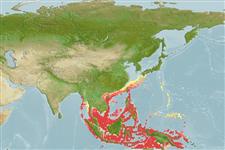Common names from other countries
>
Eupercaria/misc (Various families in series Eupercaria) >
Lutjanidae (Snappers) > Etelinae
Etymology: Pristipomoides: Greek, pristis = saw + Greek, poma, -atos = cover, operculum + Greek, oides = similar to (Ref. 45335).
More on author: Bleeker.
Environment: milieu / climate zone / depth range / distribution range
นิเวศวิทยา
เกี่ยวกับทะเล,น้ำเค็ม สัตว์น้ำหน้าดิน; ระดับความลึก 40 - 120 m (Ref. 12260). Tropical; 32°N - 12°S, 93°E - 157°E (Ref. 55)
Eastern Indian Ocean: Andaman Sea. Western Pacific: New Guinea to Sumatra, north to the Ryukyu Islands. Present in Australia from the North West Shelf to Tweed Heads in New South Wales (Ref. 6390). Records from the western Indian Ocean need verification.
Length at first maturity / ขนาด / น้ำหนัก / Age
Maturity: Lm ?, range 28 - ? cm
Max length : 70.0 cm TL เพศผู้/กระเทย; (Ref. 55); น้ำหนักสูงสุดที่มีการรายงาน: 2.2 kg (Ref. 1451); อายุสูงสุดที่ได้รายงาน: 11 ปี (Ref. 3090)
เงี่ยงครีบหลัง (รวม) : 10; ก้านครีบอ่อนที่หาง (รวม) : 11 - 12; เงี่ยงครีบก้น: 3; ก้านครีบอ่อนที่ก้น: 8. Interorbital space flat. Bases of dorsal and anal fins without scales, their last soft rays extended into short filaments. Pectoral fins long, reaching level of anus. Scale rows on back parallel to lateral line. Overall color rosy red; the top of the head with longitudinal vermiculated lines and spots of brownish yellow; the dorsal fin with wavy yellow lines.
Sharptooth snappers are found in tropical and sub-tropical deep waters. They are found in schools and live in areas of hard, rocky and uneven sea floor (Ref. 27354). They feed on benthic invertebrates and fishes.
Studies in South China Sea (Ref. 28116) and Hawaii (Ref. 28117) suggest that this species is a serial spawner (Ref. 28115).
Allen, G.R., 1985. FAO Species Catalogue. Vol. 6. Snappers of the world. An annotated and illustrated catalogue of lutjanid species known to date. FAO Fish. Synop. 125(6):208 p. Rome: FAO. (Ref. 55)
IUCN Red List Status (Ref. 130435)
CITES (Ref. 128078)
Not Evaluated
Threat to humans
Harmless
Human uses
การประมง: มีการค้าเพียงเล็กน้อย
เครื่องมือ
Special reports
Download XML
แหล่งที่มาจากอินเตอร์เน็ต
Estimates based on models
Preferred temperature (Ref.
115969): 23.4 - 28.2, mean 27.2 (based on 260 cells).
Phylogenetic diversity index (Ref.
82804): PD
50 = 0.5005 [Uniqueness, from 0.5 = low to 2.0 = high].
Bayesian length-weight: a=0.01175 (0.00693 - 0.01992), b=2.96 (2.82 - 3.10), in cm Total Length, based on LWR estimates for this species & Genus-body shape (Ref.
93245).
ระดับชั้นอาหาร (Ref.
69278): 4.2 ±0.61 se; based on food items.
ความสามารถในการกลับคืนสู่ปกติ (Ref.
120179): ขนาดกลาง, เวลาต่ำสุดที่จะทำให้ประชากรเพิ่มขึ้นเป็น 2 เท่าใช้เวลา 1.4 - 4.4 ปี (K=0.25; tmax=11; Fec=760,000).
Fishing Vulnerability (Ref.
59153): Moderate vulnerability (39 of 100).
